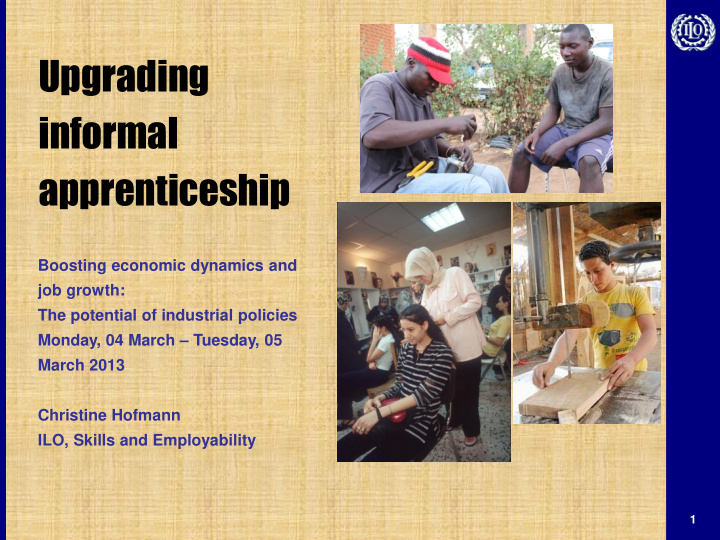



Upgrading informal apprenticeship Boosting economic dynamics and job growth: The potential of industrial policies Monday, 04 March – Tuesday, 05 March 2013 Christine Hofmann ILO, Skills and Employability 1
Five major elements of apprenticeship according to ILO R60 and R117 • Training agreement (contract) between learner (apprentice) and trainer/ mentor (master craftsperson) • The core of training takes place in an enterprise • Training for a trade/occupation that leads to employability • Systematic and long-term (initial training) • Training system and not just a way of learning Informal apprenticeship - is embedded in social norms, customs and traditions of a society - remains a major provider of skills, in particular in countries with large informal economies 2
Distribution of young workers/learners in the informal economy by training, sex and city Source: Nordman and Pasquier-Daumier. 2012. Vocational education, on-the-job training and labour market integration of young workers in urban West Africa. 3
How well does the system work? Drop-out rates of apprentices 50% 45% 40% 35% 30% 25% 20% 15% 10% 5% 0% Malawi Tunisia Egypt Estimate Germany United West Africa Kingdom Source: Hofmann and Okolo. 2013 (forthcoming). Transitions in informal apprenticeship: Results from ILO research in several African countries, in: in: Akoojee, S.; Gonon, P.; Hauschildt, U.; Hofmann, C. (Eds.) 2013, forthcoming, Apprenticeship in a Globalised World: Premises, Promises and 4 Pitfalls, International Network of Innovative Apprenticeship, Berlin
Moving from a static informal institution to a dynamic one fostering productive transformation o Quality and effectiveness : Combine on-the-job with off-the-job training, upgrade skills of craftspersons o Skills recognition : Introduce assessment by industry (associations, chambers etc.) o Value chains: Strengthening upward linkages to larger enterprises o Public-private partnership : share financial cost between apprentice, company and government o Broad skills : Apprentices rotate between companies with different specializations o Conflict resolution : Industry associations, chambers, community groups monitor the training agreement and mediate in case of contract breach 5
Case study: Upgrading IA in Benin Facts: • Informal apprenticeship trains around 150.000 youth • Strong organization of micro and small businesses: Crafts federation (FENAB) organizes 50.000 craftspersons Two approaches to upgrading 1) Build on informal institution: Agreement between local municipality and local crafts associations to organize end-of- apprenticeship exams. 2) Create new formal institution: Dual apprenticeship in selected trades, funded by Results: 1) Successful candidates receive a certificate, names are broadcast by local radio station, strengthen quality concerns of craftspeople 2) 3000 formalized informal apprentices 6
ILO tools and publications • Policy brief • Resource guide • Workshop report • Research publications - Forthcoming: Comparison of informal apprenticeship systems across countries - in Tanzania, Malawi, Egypt, North Sudan, Tunisia, Bangladesh - in Ivory Coast and DRC (effect of reintegration of ex child soldiers on informal apprenticeship – jointly with IPEC) - in Ghana: Financial arrangements, youth livelihoods • Technical cooperation projects in: Zimbabwe, Bangladesh, Benin, Burkina Faso, Tanzania, Egypt 7
Thank you for your attention! Christine Hofmann hofmann@ilo.org 8
Recommend
More recommend